Yellow curry powder is a mild curry mixture that curry lovers worldwide adore. This easy curry powder is commonly used in Thai food and can elevate any dish to new levels of deliciousness. It can be made in less than 10 minutes!
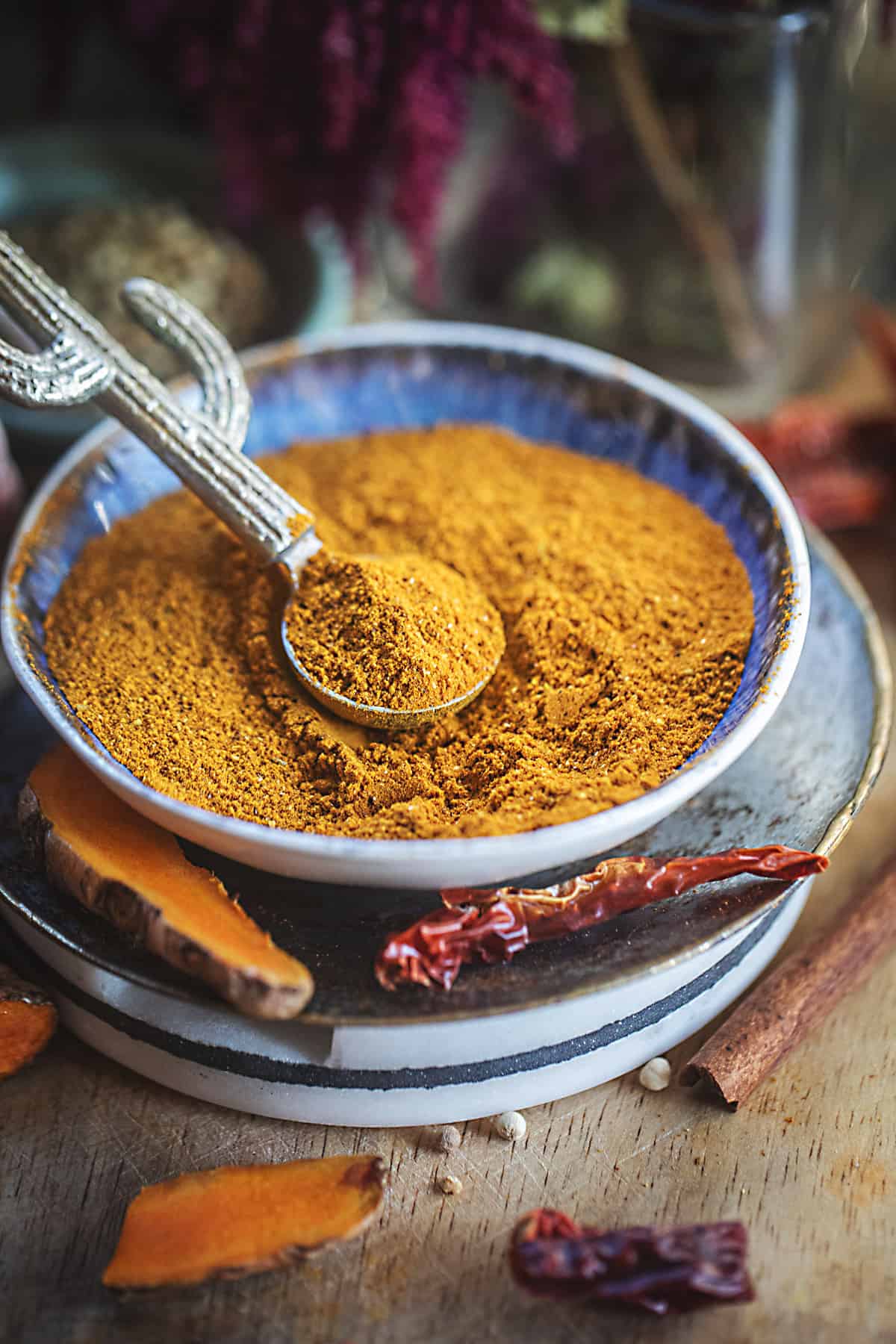
Check out these recipes using yellow curry powder. Thai curry crab Pad Pong Karee, Thai yellow fried rice, chicken satay, and pineapple fried rice with curry powder.
For more spices used in Thai cooking, check out my easy Chinese five-spice powder. Read about the different spices used in Thai cooking here.
Jump to:
- What is Yellow Curry Powder?
- Yellow curry powder in Thai cooking
- yellow curry powder vs Yellow curry paste
- Ingredients for homemade yellow curry powder
- How to Make Homemade Yellow Curry Powder
- Helpful Kitchen Notes and Tips
- How to Serve Homemade Yellow Curry Powder
- Helpful Kitchen Tools for This Recipe
- Variations
- Storing Leftovers
- Japanese vs. Madras vs. Indian curry powder
- Frequently Asked Questions
- Easy Yellow Curry Powder
- More Recipes You'll Love
- More Recipes
What is Yellow Curry Powder?
Yellow curry powder is a complex spice blend featuring a combination of ground and whole spices, capturing the essence of traditional Thai and Indian cooking.
This beautiful yellow-colored powder is a key ingredient in various Thai curries and other recipes, adding depth of flavor and a mild seasoning blend.
Yellow curry powder in Thai cooking
In Thai cooking, there's no traditional Thai yellow curry powder. Instead, Thai grocery stores sell Japanese or Indian-flavored powder for Thai dishes, each with unique ingredients.
I often use both powders in my recipes, but for most of my Thai recipes, I prefer the Japanese style, which has more Thai spices, like white peppers and Thai chili flakes.
For complex layers of flavors with warming and fragrant spices with a lot of Indian cooking, I use Indian or Madras powder.
yellow curry powder vs Yellow curry paste
Yellow curry paste and powder are two different ways to flavor your dishes. The powder blends various spices, including turmeric, cumin, coriander, and fenugreek.
It adds a warm and aromatic touch to your meals.
On the other hand, yellow curry paste is made by grinding fresh ingredients like lemongrass, galangal, garlic, and shallots into a smooth paste. It has a more intense flavor and incorporates the herb flavors beautifully.
While curry powder can be sprinkled into dishes, curry paste is more versatile and can be used as a spice paste or mixed with coconut milk to create a delicious curry sauce.
So, depending on your preference and the level of convenience you seek, you can choose between the two.
Ingredients for homemade yellow curry powder

- Coriander seeds or powder. I used coriander seeds and then ground them to powder. The seeds are fresher and more flavorful than the powder.
- Turmeric powder. The heart and soul of the curry give it the beautiful yellow color it is known for.
- Chili powder. Chili powder gives the yellow curry powder its heat. You can grind red pepper flakes into fine powder to add to the spice blend. Cayenne pepper is the best substitute.
- Paprika. Adds a deep reddish color and a sweet and mild peppery taste to the powder. I love using this Hungarian-style paprika brand.
- Ground galangal. Or galangal powder. They can be found in the International or Asian market in the spices section.
- White peppercorns. I used whole peppercorns, toast them, and then grind them to powder. Black peppers are ok for substitutes.
- Fenugreek seeds Give it a sweet and nutty flavor like caramelized brown sugar gives
- Cumin seeds. Cumin seeds are citrusy with a hint of peppery taste and have the best flavor profile.
- Cinnamon. Use whole cinnamon sticks if you have them. They will add a note of fragrance and nutty aroma.
How to Make Homemade Yellow Curry Powder
Step 1: Gather Your Spices. Separate the seed spices from the powder. Break your cinnamon sticks into small pieces as best you can.
Step 2: Toast the whole spices. Over medium heat, dry toast your seeds or whole spices in a large skillet. Cast iron is excellent for toasting the spices.
Step 3: Spice Grinding. allow the spice to cool before grinding. Using a spice grinder, blend the toasted seeds into a fine powder.

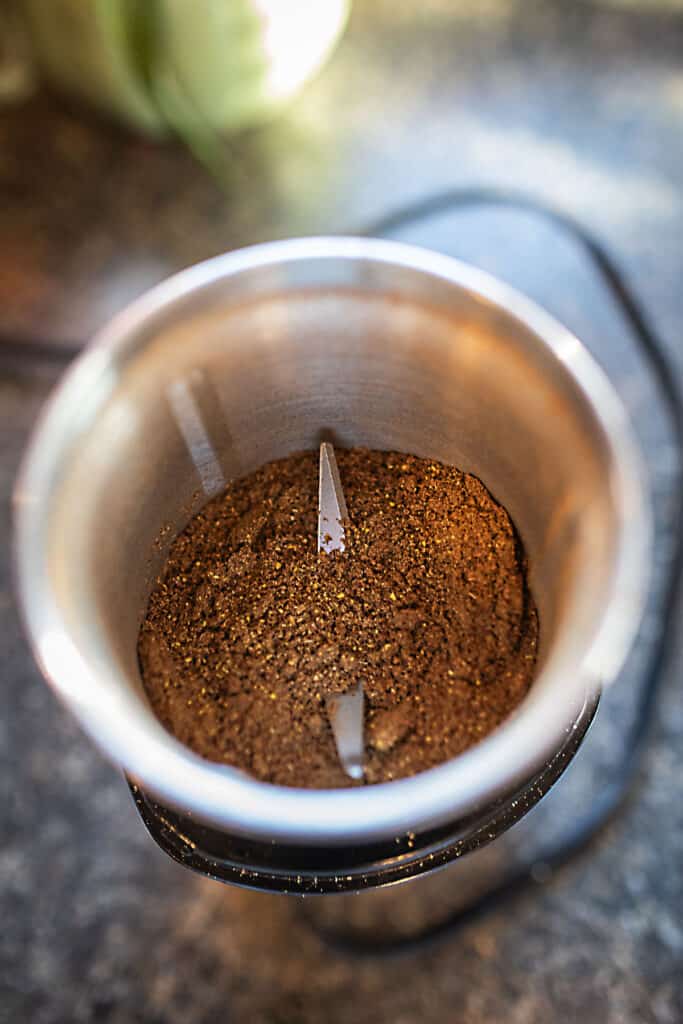
Step 4: Combine the ground spices. Combine the freshly ground and powdered spices in a large skillet or cast iron pan.
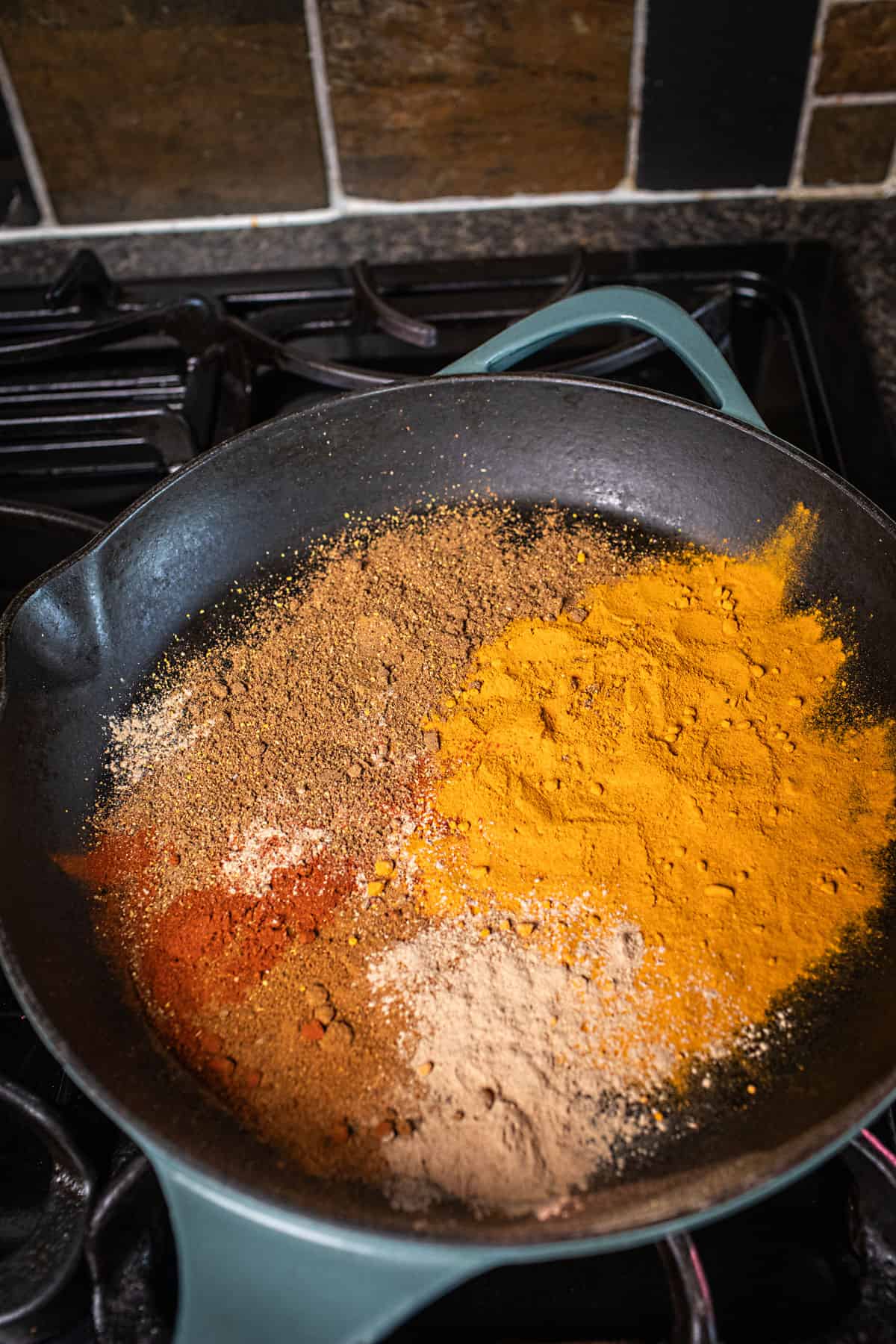
Step 5. Heat the pan to medium heat and stir the mixture with a wooden spoon. Keep a close eye on your powder. Dry toasting for 3-4 minutes or until fragrant. Remove the powder mixture from the pan and allow to cool.

Step 6: Sift the toasted powder through a small fine mesh strainer to remove any runaway large pieces of the spices. Store in an air-tight container to preserve freshness and flavor.
Helpful Kitchen Notes and Tips
- A spice grinder is extra handy for making your curry powder. A small food processor will not work well because it's too big for the small amount of spices used.
- A heavy-duty stone mortar and pestle is another great tool to have in the kitchen for a manual pounding method.
- Use high-quality spices or organic spices For the best results. Fresh spices are nearly impossible, but if you access a specialty store with spices, grab them there.
- Enhance the freshness of your yellow curry powder by grinding whole spices just before use for better results in your recipes.
How to Serve Homemade Yellow Curry Powder
Use your curry powder to make curries, seafood dishes, dressings, or spice up potato salad. Use it in Thai pineapple fried rice and Thai chicken satay.
Helpful Kitchen Tools for This Recipe
A high-quality spice grinder is great for making a fine powder.
A fine mesh strainer is helpful for sifting your powder mix before storing it to help remove charge pieces that may have escaped the spice grinder blades.
Variations
Tailor the spice level to your preference by adjusting the blend's black pepper and mustard seeds.
Storing Leftovers
Store your homemade curry powder in air-tight containers in a cool, dark place to maintain its potency for future use.
Japanese vs. Madras vs. Indian curry powder
Japanese yellow curry powder, Madras curry powder, and yellow curry powder are distinct spice blends that add mild curry flavor to dishes. Each powder has unique characteristics suitable for specific cuisines.
Madras Curry Powder
Madras curry powder from southern India has a robust and spicy flavor with aromatic spices like coriander, cumin, mustard seeds, fenugreek, and turmeric.
Indian Yellow Curry Powder
Indian curry powder is milder, with turmeric, cumin, coriander seeds, ginger, cinnamon, and cardamom. These earthy spices are the essence of traditional Indian cooking, enhancing Indian curry dishes delicately.
Japanese Yellow Curry Powder
Japanese yellow curry powder, inspired by Indian curry, is milder with ingredients like turmeric, coriander, cumin, ginger, and garlic. It complements Japanese cuisine without overpowering the earthy flavors.

Frequently Asked Questions
Yellow curry powder is a dry spice blend, while curry paste is a wet mixture containing ground spices, herbs, and shrimp paste.
There is no substitute. Its unique blend of ingredients cannot be replicated, but you can easily find various brands in most grocery stores, both big and small.
No. Garam masala and yellow curry powder have spices that differ from yellow.
Yes, yellow curry powder is known for its mild flavor profile, making it suitable for those who prefer a less spicy option in their dishes.
Yes. It contains various spices with potential health benefits, such as anti-inflammatory properties from turmeric and antioxidant-rich coriander.
Masala is a spice blend from Indian cuisine, while yellow curry is a Thai spice blend. They differ in their combination of spices and usage in various regional dishes.
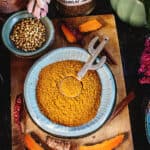
Easy Yellow Curry Powder
- Total Time: 10 minutes
- Yield: ⅓ cup
- Diet: Gluten Free
Description
Yellow curry powder is a mild curry mixture that curry lovers worldwide adore. This easy yellow curry powder is commonly used in Thai food and can elevate any dish to new levels of deliciousness. It can be made in less than 10 minutes!
Ingredients
*only use half the amount of ground spices when substituting powder for whole spices.
- 2 tablespoons turmeric powder
- 2 tablespoons coriander seeds or 1 tablespoon coriander powder
- 1 teaspoon chili powder
- 1 ½ teaspoon paprika
- ½ teaspoon galangal powder
- 1 teaspoon whole white peppercorns or ½ teaspoon ground white pepper powder
- 2 teaspoons fenugreek seeds or 1 teaspoon fenugreek powder
- 1 teaspoon cumin seeds or ½ teaspoon cumin powder
- 1 teaspoon ground cinnamon or one 4-inch stick or ½ teaspoon ground cinnamon
Instructions
- Separate the whole spices (seeds) from the powdered ones. Break your cinnamon sticks into small pieces as best you can.
- Toast the whole spices. Over medium heat, dry toast your seeds or whole spices in a large skillet. Cast iron is excellent for toasting the spices.
- Spice Grinding. Allow the spice to cool before grinding. Using a spice grinder, blend the toasted seeds into a fine powder.
- Combine the ground spices. Combine the freshly ground and powdered spices in a large skillet or cast iron pan.
- Heat the pan to medium heat and stir the mixture with a wooden spoon. Keep a close eye on your powder. Dry toasting for 3-4 minutes or until fragrant. Remove the powder mixture from the pan and allow to cool.
- Sift the toasted powder through a small fine mesh strainer to remove any runaway large pieces of the spices. Store in an air-tight container to preserve freshness and flavor.
Notes
- A spice grinder is extra handy for making your curry powder. A small food processor will not work well because it's too big for the small amount of spices used.
- A heavy-duty stone mortar and pestle is another great tool to have in the kitchen for a manual pounding method.
- Use high-quality spices or organic spices For the best results. Fresh spices are nearly impossible, but if you access a specialty store with spices, grab them there.
- Enhance the freshness of your yellow curry powder by grinding whole spices just before use for better results in your recipes.
- Prep Time: 5
- Cook Time: 5
- Category: Spices
- Method: stovetop
- Cuisine: Thai
More Recipes You'll Love
- Thai yellow curry with chicken
- Thai green tea
- Tamarind black tea
- Kabocha squash dessert with coconut milk
- Green curry paste
- Thai yellow curry paste
More Recipes
Looking for other recipes like this? Try these:


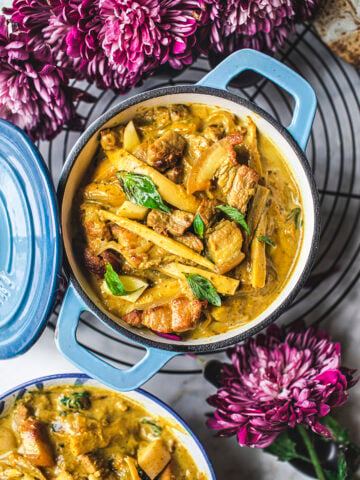



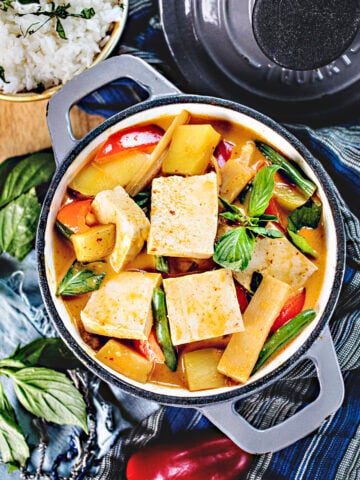
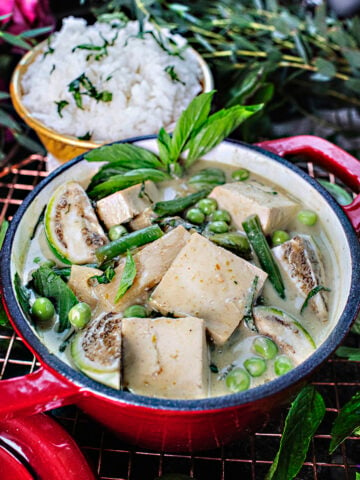

Leave a Reply